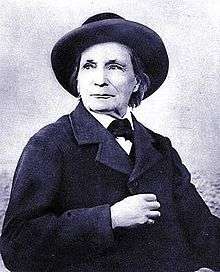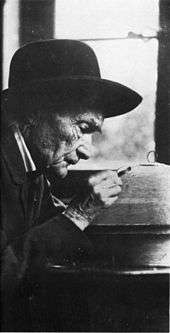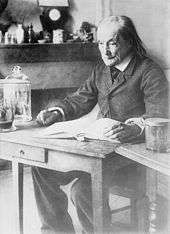Jean-Henri Fabre
| Jean-Henri Fabre | |
|---|---|
 | |
| Born |
December 22, 1823 Saint-Léons, Aveyron, France |
| Died |
October 11, 1915 (aged 91) Sérignan-du-Comtat, Vaucluse, France |
| Nationality | French |
| Fields | Entomology |
| Known for | Popular books on insects |
Jean-Henri Casimir Fabre (December 22, 1823 – October 11, 1915) was a French entomologist, and author known for the lively style of his popular books on the lives of insects.[1]
Biography
Fabre was born on December 22, 1823 in Saint-Léons in Aveyron, France. Fabre was largely an autodidact, owing to the poverty of his family. Nevertheless, he acquired a primary teaching certificate at the young age of 19 and began teaching in Carpentras whilst pursuing further studies. In 1849 he was appointed to a teaching post in Ajaccio (Corsica), then in 1853 moved on to the lycée in Avignon.

Fabre was a popular teacher, physicist, chemist and botanist. However, he is probably best known for his findings in the field of entomology, the study of insects, and is considered by many to be the father of modern entomology. Much of his enduring popularity is due to his marvelous teaching ability and his manner of writing about the lives of insects in biographical form, which he preferred to a clinically detached, journalistic mode of recording. In doing so he combined what he called "my passion for scientific truth" with keen observations and an engaging, colloquial style of writing. Fabre wrote:
Others again have reproached me with my style, which has not the solemnity, nay, better, the dryness of the schools. They fear lest a page that is read without fatigue should not always be the expression of the truth. Were I to take their word for it, we are profound only on condition of being obscure.
His Souvenirs Entomologiques is a series of texts on insects and arachnids. He influenced the later writings of Charles Darwin, who called Fabre "an inimitable observer". Fabre, however, was a Christian who remained sceptical about Darwin's theory of evolution, as he always held back from all theories and systems. His special force was exact and detailed observation, field research, always avoiding general conclusions from his observations, which he considered premature.[2][3]
In one of Fabre's most famous experiments, he arranged Pine Processionary caterpillars to form a continuous loop around the edge of a pot. As each caterpillar instinctively followed the silken trail of the caterpillars in front of it, the group moved around in a circle for seven days.[4]
He died on October 11, 1915.[5]
Works

| Library resources about Jean-Henri Fabre |
| By Jean-Henri Fabre |
|---|
- Scène de la vie des insectes
- Chimie agricole (textbook) (1862)
- La Terre (Jean Henri Fabre)|La Terre (1865)
- Le Ciel (textbook) (1867) - Scanned text on Gallica
- Le livre d’histoires, récits scientifiques de l’oncle Paul à ses neveux. Lectures courantes pour toutes les écoles (textbook) (1869) - High definition pdf file
- Catalogue des « Insectes Coléoptères observés aux environs d'Avignon » (1870)
- Les Ravageurs (1870)
- Les Auxiliaires, récits de l’oncle Paul sur les animaux utiles à l’agriculture (1873) High definition pdf file
- Aurore (textbook) (1874) Scanned text on Gallica
- Botanique (textbook) (1874)
- L'Industrie (textbook) (1875)
- Les Serviteurs (textbook) (1875)
- Sphériacées du Vaucluse (1878)
- Souvenirs entomologiques – 1st series (1891) – (1879) – Scanned text on Gallica
- Etude sur les moeurs des Halictes (1879)
- Le Livre des Champs (1879)
- Lectures sur la Botanique (1881)
- Nouveaux souvenirs entomologiques – 2nd series (1882) – Scanned text on Gallica
- Lectures sur la Zoologie (1882)
- Zoologie (Jean Henri Fabre)|Zoologie (textbook) (1884)
- Souvenirs entomologiques – 3rd series (1886) – Scanned text on Gallica
- Histoire naturelles (textbook) (1889)
- Souvenirs entomologiques – 4th series (1891) – Scanned text on Gallica
- La plante : leçons à mon fils sur la botanique (livre scolaire) (1892) – Scanned text on Gallica
- Souvenirs entomologiques – 5th series (1897) – Scanned text on Gallica
- Souvenirs entomologiques – 6th series (1900) – Scanned text on Gallica
- Souvenirs entomologiques – 7th series (1901) – Scanned text on Gallica
- Souvenirs entomologiques – 8th series (1903)
- Souvenirs entomologiques – 9th series (1905)
- Souvenirs entomologiques – 10th series (1909)
- Fabre's Book of Insects retold from Alexander Teixeira de Mattos' translation of Fabre's Souvenirs entomologiques Scanned book
- Oubreto Provençalo dou Felibre di Tavan (1909) Text on Jean-Henri Fabre, e-museum
- La Vie des insectes (1910)
- Mœurs des insectes (1911)
- Les Merveilles de l'instinct chez les insectes (1913)
- Le monde merveilleux des insectes (1921)
- Poésie françaises et provençales (1925) (final edition)
- La Vie des araignées (1928)
- Bramble-Bees and Others Scanned book, Project Gutenberg Full Text
- The Life of the Grasshopper. Dodd, Mead, and company, 1917. ASIN B00085HYR4
- Insect Adventures. Dodd, Mead, 1917. Selections from Alexander Teixeira de Mattos' translation of Fabre's Souvenirs entomologiques, retold for young people.
- The Life of the Caterpillar. Dodd, Mead, 1919. ASIN B00089FB2A
- Field, Forest, and Farm: Things interesting to young nature lovers, including some matters of moment to gardeners and fruit-growers. The Century Company, 1919. ASIN B00085PDU4 Full text
- This Earth of Ours: Talks about Mountains and Rivers, Volcanoes, Earthquakes, and Geysers & Other Things. Albert & Charles Boni, 1923. ASIN B000EHLE22
- The Life of The Scorpion. University Press of the Pacific, 2002 (reprinted from the 1923 edition). ISBN 0-89875-842-4
- The Glow-Worm and Other Beetles. Dodd, Mead, 1919. ASIN B000882F2K
- The Mason Bees (Translated) Garden City, 1925. ASIN B00086XXU0; Reprinted in 2004 by Kessinger Publishing; ISBN 1-4179-1676-1; ISBN 978-1-4179-1676-4 Scanned book, Project Gutenberg Full Text
- Curiosities of Science. The Century Company, 1927. ASIN B00086KVBE
- The Insect World of J. Henri Fabre. Introduction and Interpretive Comments by Edwin Way Teale; Foreword to 1991 edition by Gerald Durrell. Published by Dodd, Mead in 1949; Reprinted by Beacon Press in 1991; ISBN 0-8070-8513-8
- The Life of the Spider (Translated) Preface by Maurice Maeterlinck; Introduction by John K. Terres. Published by Horizon Press, 1971; ISBN 0-8180-1705-8 (First published by Dodd, Mead, and company in 1913, ASIN B00085D6P8) Scanned book, Project Gutenberg Full Text
- The Life of the Fly. (Translated) Fredonia Books, 2001. ISBN 1-58963-026-2; ISBN 978-1-58963-026-0 Scanned book
- The Hunting Wasps. University Press of the Pacific, 2002. ISBN 1-4102-0007-8; ISBN 978-1-4102-0007-5
- More Hunting Wasps Scanned book Project Gutenberg Full Text
- The Wonders of Instinct: Chapters in the Psychology of Insects. University Press of the Pacific, 2002. ISBN 0-89875-768-1; ISBN 978-0-89875-768-2 Scanned book, Project Gutenberg Full Text
- Social Life in the Insect World Scanned book, Project Gutenberg Full Text
- Insect life Scanned book
Legacy
The site of his birth, at St Léons, near Millau is now the site of Micropolis, a tourist attraction dedicated to popularising entomology and a museum on his life. His last home and office, the Harmas de Fabre in Provence is similarly a museum devoted to his life and work. His insect collection is preserved in the Musée Requien, Avignon.
The French post office commemorated Fabre in 1956 with a stamp depicting a portrait of him.[6] Fabre appears in the Original Video Animation Read or Die. Blood of the Mantis, a 2009 fantasy novel by the British author Adrian Tchaikovsky is dedicated to Fabre.[7]
References
- ↑ Going, Charles Buxton. (1935). Henri Fabre, Educator and Naturalist. The American Scholar. Vol. 4, No. 1, pp. 100-108
- ↑ Grant, Susan T. (1976). Reflections: Fabre and Darwin: A Study in Contrasts. BioScience. Vol. 26, No. 6. pp. 395-398
- ↑ Yavetz, Ido. (1988). Jean Henri Fabre and Evolution: Indifference or Blind Hatred? History and Philosophy of the Life Sciences. Vol. 10, No. 1. pp. 3-36.
- ↑ Fabre, The Life of the Caterpillar. Chapter VI. The Pine Processionary: The Stinging Power.
- ↑ "Henri Fabre Dies In France At 92. Noted Entomologist Was Described by Victor Hugo as 'The Insects' Homer'". New York Times. October 12, 1915. Retrieved 2012-10-01.
Henri Fabre, the entomologist, is dead. He was born in France in 1823. Henri Fabre, whom Victor Hugo described as 'The Insects' Homer,' ...
- ↑ Fabre commemorative postage stamp
- ↑ Tchaikovsky, Adrian. Blood of the Mantis. ISBN 978-1-61614-199-8.
Biographies
- G.V. Legros, (Bernard Miall, translator), Fabre, Poet of Science. T. Fisher Unwin, 1913. (Reprinted by University Press of the Pacific, 2002, ISBN 0-89875-945-5; ISBN 978-0-89875-945-7) Scanned book
- E.L. Bouvier, The Life and Work of J.H. Fabre. Annual Report of the Smithsonian Institution, 1916, pages 587-597.
- Augustin Fabre, The Life of Jean Henri Fabre. Dodd, Mead, 1921. Scanned version on the Internet Archive
- Percy F. Bicknell, The Human Side of Fabre. The Century Company, 1923.
External links
| Wikiquote has quotations related to: Jean-Henri Fabre |
| Wikimedia Commons has media related to Jean Henri Fabre. |
- Works by Jean-Henri Fabre at Project Gutenberg
- Works by or about Jean-Henri Fabre at Internet Archive
- Works by Jean-Henri Fabre at LibriVox (public domain audiobooks)

- Jean-Henri Fabre: e-museum
- The Amazing World of the Insects of Jean-Henri Fabre
- Micropolis In English
- The museum and birth house of Jean-Henry Fabre In French
